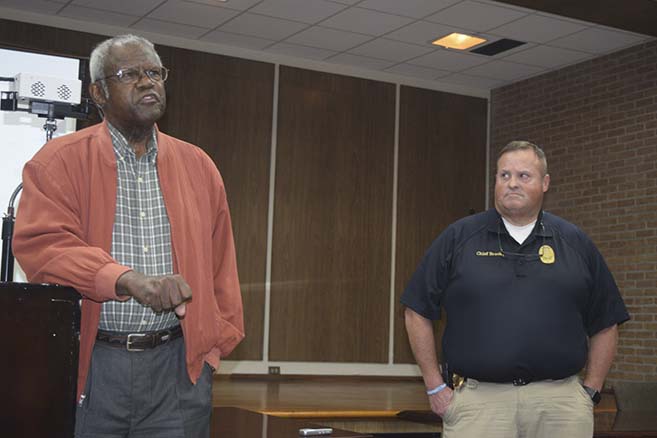
By DON FLETCHER
News Staff Writer
No curfew was imposed, and no real solution was offered to the problem of violent crime in Atmore during the public meeting held last Thursday evening (January 30). But several people’s eyes were opened, and several individuals expressed their sentiments on how to deal with the problem.
A crowd of more than 150 — black, white, old folks, young adults and a scattering of teenagers — created a standing-room-only scenario as people filled the seats and lined the walls of Atmore City Hall Auditorium.
Although a potential curfew was the reason for the meeting, the evening’s main theme was violence, especially violence that includes guns. Topics ranging from the need for residents to band together against crime, to the need for stricter parenting and more attendance in church, were discussed during the hour-long session.
Police Chief Chuck Brooks moderated the meeting. Mayor Jim Staff, all five city council members, City Clerk Becca Smith, City Attorney Larry Wettermark and Municipal Court Judge Karean Reynolds were all in attendance, but none of them spoke.
“We’re here to talk about and have an open discussion about the recent events, violent crimes, in our city,” Brooks said as people continued to file into the auditorium. “Me and my police department are only effective if you, the community, allow us to be. I want to ask you how we can eliminate violence in our great city.”
Brooks, an Atmore native, said he is literally stunned by the amount of gun violence that has sprung up in the city of his birth.
“I have a vested interest, and I’m sick and tired of violence in this community,” he said, noting the size of the crowd. “From the looks of it, you do, too. It’s unreal that we have to send 18-20 officers to an ECHS football game, but that’s what it’s gotten to.” [ECHS is Escambia County High School.]
He said he has talked with Superintendent of Schools Dr. Michele Collier, and beginning next season, unaccompanied juveniles won’t be allowed inside the gates of Herbert Barnes Field.
The meeting was held to discuss the possibility that some type of curfew might be needed within the city limits to help curb the gun violence. Brooks said he and the city attorney had reached the conclusion that there was probably no curfew that would be fair to everyone.
“What type of curfew would we enact?” he asked. “Would it be for a certain area of town? The gunshot reports we receive are pretty much divided equally among the four quadrants of the city. Would it be for juveniles? Most of the suspects in the gun violence calls we get are in the 20-25-year range. And if you have a dual enrollment student, that student couldn’t go to the college out at the interstate at night.
“Would it be for adults? Would it be for everybody? That’s not going to work. People have got to be able to move freely about.”
There were also several people who took advantage of the public forum to complain that they didn’t get the respect they felt they deserved from city police. Although one or two of those complaints turned into raised-voice tirades against the police — answered by “amens” and other words of agreement from some of the crowd — most of those venting their anger were polite and made their points relatively quietly.
Many came to the front of the room to speak, among them retired pastor Alphonso Williams Sr., who gained shouts of approval when he said the problem was created inside the home and outside the church.
“A curfew would be treating the symptoms of the problem, not the problem itself,” Williams said. “The problem comes from the home, a lack of parental home training. Most of these people causing the problem are from one-parent or no-parent homes. I’ve also discovered that the best place to deal with human behavior is the pulpit on Sunday morning.”
Brooks suggested four primary ways people could help cut down the frequency of violent acts within the city — Neighborhood Watch, APD’s Project Eye, CrimeStoppers or use of the police department’s anonymous tip line (251-368-9141, extension 1168).
He also added a fifth way, one he said is lacking within Atmore.
“If you see something, say something,” he said. “So many times, people call us to complain about a crime, then refuse to talk to us when we get there. They’re scared, and I don’t blame them, but we can’t do anything without their help.
“The easiest thing to do is put handcuffs on somebody. The hard part is getting a successful prosecution in court. We have to have good science, good technology and eyewitnesses. It’s hard to make a case without all three.”
Sandra Gray said the Neighborhood Watch idea seemed to her the best answer.
“We can’t sit home and wait for a solution,” she said. “We need to start a Neighborhood Watch, everybody on every street. Time is running out; our children are running crazy. We don’t need to be afraid to go somewhere in Atmore. Let’s come together – black, white, orange, green or purple, I don’t care. We are all in this together.”
Mayor Jim Staff said after the meeting that, despite the few anti-police outbursts, the meeting met its intended purpose.
“It was quieter than I thought it would be,” the mayor said. “I think more people are now understanding the problem than did before the meeting.”
Cleitus Walker of Atmore agreed the meeting was helpful, but agreed with the Rev. Williams that a good dose of church-learning could go a long way in helping cut the incidence of violence.
“Anytime people can come together and talk with the mayor and police chief, it’s a good thing,” he said. “Some will believe that tonight’s meeting didn’t do a thing; some will believe it did. Hopefully, the church will get more involved.”
The police chief’s final appeal was that everyone in the community work together to come up with solutions to the dilemma.
“This is not a black problem; it’s not a white problem, it’s a community problem,” he said. “I don’t have a magic wand that I can wave and fix this. I need y’all, all of you.”
